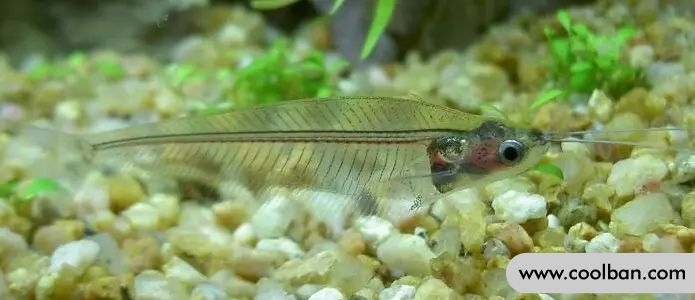How to raise glass catfish
The glass catfish is transparent throughout, and the two whiskers in its mouth are very similar to cat tentacles, hence the name glass catfish. The glass catfish swims very fast, and when stationary, it tilts upward at a 40-degree angle. Occasionally the glass catfish takes on a rainbow of dreamy colors at right angles to the light refraction.
Appearance characteristics of glass catfish
The shape of the glass catfish is very special. The whole body is transparent, and there are two whiskers like cat whiskers in the mouth. Glass catfish are not easy to spot without a careful look at them. Some people also call it "ghost fish" because the bones of the fish can be seen floating in the water.
The average adult glass catfish is 12-18 cm long. The glass catfish gets its name from its transparent body and two long whisker-like tentacles that grow in its mouth. Their swimming form is fast. when they stand still, they tilt up 40 degree. Their crystal clear bodies swayed slightly. Occasionally, when light is refracted at the right angle, they reflect a rainbow of colors like a prism refracted by sunlight.
The glass catfish is 10-12 cm long and resembles a willow leaf. The tip of the head and snout, and the mouth has 2 long tentacles, which often stretch forward or rotate freely to detect currents, enemies, obstacles and assist in foraging. The chest and abdomen are extremely short, with the head, chest and abdomen only accounting for 1/4 of the total length. The caudal peduncle is very short, the caudal fin is forked, the dorsal fin is degenerated, the base of the anal and anal fins is very long, and the front and rear fin rays are equal in width. The whole body is transparent, and the spine, spines, fin rays and internal organs are clearly visible. The color is pale green like jade, like high-grade jade carving craftsmanship.

Glass catfish breeding environment
Glass catfish are mild-mannered and like to keep the same species together, otherwise a single glass catfish will feel lonely and die. It can also be mixed with small, tempered fish. The water for raising glass catfish needs to have a certain hardness, but it cannot exceed 10°dh, and the suitable water temperature is 22-26 degrees Celsius.
In fact, the water quality of raising glass catfish only needs to pay attention to maintaining the concentration of nitrite. Glass catfish are gentle, timid, do not like to swim, and often hide in dark corners. They are suitable for growing a large number of aquatic plants in the breeding environment for them to perch and hide. Glass catfish are more sensitive to changes in water temperature. When the water temperature is lower than about 18 ℃, their originally transparent bodies will gradually turn white. If the water temperature continues to drop, their entire body will curl, stiffen and die.

Points for raising glass catfish
It is relatively easy to raise and feed glass catfish. Common live baits, such as water worms, cladocerans, artemia, etc., will be eaten, and the body length of natural water growth can reach 8 cm.
Newly hatched larvae are pale yellow with a beating heart, blood flowing, and a large unabsorbed yolk sac in the abdomen. in the first 2 to 3 Days, the larvae rest at the bottom of the water and do not need to be fed at this time. Pay attention to remove the egg membrane and white dead eggs in time, replace the water with new water every day, and place the fry in a greenhouse at 25°C (can be placed in an air-conditioned room). When the larvae are 3 to 4 days old, they can swim freely (horizontal swimming) and begin to forage. At this time, you can take a little egg yolk from the wire mesh and gently stir in the water until the water is slightly yellow. Proper feeding calcium mother tablets, oxytetracycline, etc., to improve the survival rate of fry. Eat smaller meals more often, every day 3 to 4 Second-rate. Paramecia, brewer's yeast, etc. were added at the age of 7 to 10 days, and Artemia nauplii were fed at the age of 3 weeks, and compound feed was gradually added. In the feeding process, pay attention to the changes in water quality, change the water frequently, and feed less to ensure the healthy growth of fry.
